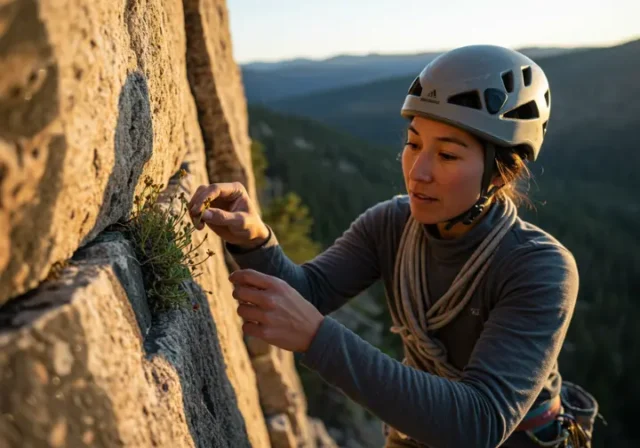In this article
There is a profound, intimate connection between a climber and the rock, a relationship built on trust, challenge, and respect for the vertical world. But these towering stone faces are more than just our playgrounds; they are fragile ecosystems. This article seeks to empower climbers with the knowledge to become dedicated stewards of these unique habitats. We, as the guardians, will explore the cliff ecology for climbers, understand our ecological impact, and detail actionable strategies to transform us from users into protectors, ensuring the future of both biodiversity and climbing access.
Understanding the Vertical Wilderness: The Unique and Fragile Ecology of Cliffs
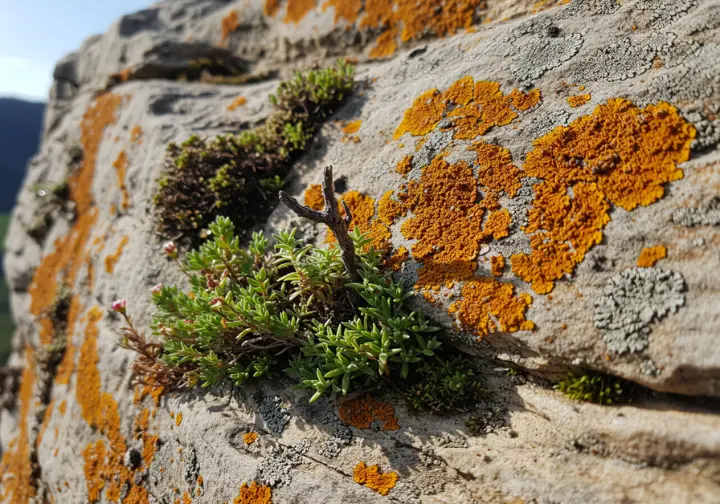
To become responsible stewards, we first need to explore the specific ecological characteristics that make cliffs biodiversity hotspots. It is crucial to understand why these seemingly barren cliff environments are ecologically significant and uniquely vulnerable to disturbance.
What Makes Cliffs Ecologically Unique and Significant?
Contrary to their stark appearance, cliffs are vibrant biodiversity hotspots. They harbor a surprising array of specialized life, including rare Cliff-Dwelling Plants (CDPs), lichens like colourful rock tripe, mosses, and even ancient trees. Their ecological importance is disproportionate to their land coverage, hosting a high percentage of a region’s unique cliff biodiversity. For example, these formations are home to 35-40% of Europe’s endemic plant taxa, making them invaluable contributors to regional biodiversity.
The geological makeup of a cliff—whether it’s made of intrusive igneous rocks, limestone, or sandstone—creates a mosaic of microhabitats with distinct properties. These diverse rock types influence soil pH and water retention, which directly dictates the plant and animal communities that can thrive on any given rock face. This means conservation strategies cannot be one-size-fits-all; they must be tailored to the specific rock type of the crag.
Cliffs also generate unique microclimates distinct from the surrounding landscape, shaped by aspect, shade, and wind. These specialized conditions can create a stable refuge that fosters assemblages of life unable to survive elsewhere. For example, the orientation of rocky crevices can dramatically affect moisture and seedling survival, highlighting the sensitivity of these micro-habitats where some organisms find shelter as rare and precious species in harsh habitats.
Why Are Cliff Ecosystems So Fragile and Vulnerable?
The primary source of fragility in cliff ecosystems is the extremely harsh abiotic conditions they endure. These habitats are defined by thin soil, nutrient-poor substrates, and limited space, all while being exposed to extreme temperatures, desiccation, and gravitational forces. The life that exists on these sheer cliffs must be highly adapted, and any additional stress can have an outsized negative effect, accelerating cliff erosion.
A critical vulnerability is the incredibly slow pace of life and recovery for cliff-dwelling species. Many cliff plants and lichens grow exceptionally slowly, meaning recovery from even minor disturbances can take decades or centuries—if it happens at all. Research shows that some disturbed rock faces can undergo a state of “arrested recovery,” becoming permanently barren due to this combination of a harsh environment and the slow life cycle of its inhabitants.
Cliffs often function as “ecological islands,” isolated from similar habitats by different types of terrain. This isolation drives specialization and high rates of endemism but also makes populations extremely vulnerable. If a local population on a cliff “island” is wiped out, natural recolonization from other areas is often difficult or impossible, which can lead to the extinction of a species unique to that single location. This isolation is a key factor in cliffs contributing more to the biodiversity of a region than other landscapes.
Cliffs as Critical Refugia for a Changing World
Historically, the inaccessibility of cliffs has made them vital habitats, protecting species from widespread pressures like grazing, competition, and past climate shifts. This sanctuary effect has allowed ancient, slow-growing trees to survive for over a thousand years and has provided a safe haven for less competitive species to persist. They are, in effect, living museums of ancient life and geological wonders.
In the face of modern climate change, the role of cliffs as refugia is becoming even more critical for conservation. As global temperatures rise, some threatened/endangered species are actively migrating to the cooler, more stable microclimates offered by cliff faces to survive. These vertical landscapes may represent the last possible critical habitat for certain plants and animals. This highlights the need for better inventorying and monitoring of cliff ecosystems.
The increasing reliance of flora and fauna on these cliff refuges elevates the responsibility of the climbing community to act with exceptional care. If rock climbing activities introduce new stresses, such as vegetation removal or soil compaction at the base of the rock, they can compromise the very microhabitats these species depend upon for survival. This places climbers at the forefront of protecting ecosystems of growing importance.
The Climber’s Footprint: Understanding Our Impacts on Cliff Environments
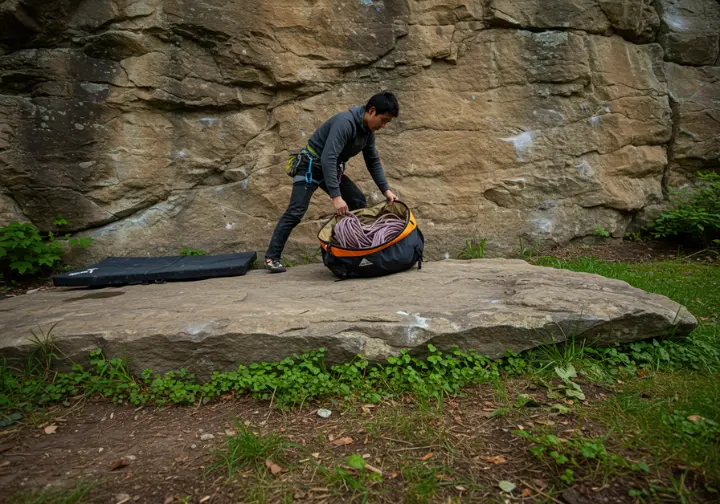
A clear-eyed assessment of the various ways climbing activities can impact cliff ecosystems is essential. It’s helpful to break down the specific environmental impacts on rock surfaces, vegetation, soil, and wildlife to build a foundation for understanding how to minimize harm.
Physical Impacts on Rock, Vegetation, and Soil
The most direct impact of cliff climbing is the physical wear on the rock itself from hands, feet, and gear, which can polish holds and destroy delicate features, especially on soft rock like sandstone. Furthermore, climbing chalk (magnesium carbonate) not only creates visual blight but can also alter the pH of the rock surface. Studies show this change can negatively affect the germination and survival of rock-dwelling ferns and mosses, demonstrating an impact beyond aesthetics.
Protecting cliff vegetation is a key responsibility. Cliff plants are highly susceptible to damage during route cleaning or by the passage of climbers and boulderers. Studies reveal significant reductions in plant diversity on climbed routes, a process that alters plant species composition, cover, and richness. For instance, one study on the Niagara Escarpment found that climbed faces had only 4% as many vascular plant species as unclimbed ones. Climbers can also inadvertently introduce invasive species to these isolated ecosystems.
Soil compaction and erosion are major issues at the base and top of cliffs and along approach trails. Heavy foot traffic in staging areas compacts the ground, denuding it of vegetation, which in turn reduces water infiltration and leads to increased soil loss. This process creates “social trails” that are both unsightly and ecologically damaging to the landscape.
Disturbances to Cliff-Dwelling Wildlife
Nesting birds, particularly raptors like peregrine falcons and eagles, are highly sensitive to human presence during their breeding season. The stress from nearby climbers can cause birds to abandon their nests, which can lead to the death of eggs or chicks. For organizations working to protect cliff-nesting raptors, seasonal closures are a critical conservation management tool to prevent this disturbance in sensitive species climbing areas.
Other wildlife, such as bats that roost in cracks and caves, are also vulnerable. Noise, vegetation removal near cave entrances, and even the installation of climbing hardware can disrupt their roosting habitat. Programs like “Climbers for Bat Conservation” are now actively recruiting climbers who can be a valuable resource in identifying the location of bat species to help protect these sensitive habitats.
The impacts on wildlife are often interconnected with other ecological damage. For example, damage to original cliff vegetation can reduce the habitat available for insects, a primary food source for many cliff-dwelling birds and bats. This highlights the need for a holistic habitat conservation approach that considers the entire ecosystem, not just individual species.
New Route Development vs. Subsequent Ascents
Research clearly shows that the initial establishment of a new climbing route has the most significant negative effect on cliff ecosystems. A study at El Potrero Chico found that new route development reduced plant species richness by 38% and overall plant abundance by over 60%. This “cleaning” phase represents a major, acute ecological disturbance that can threaten cliff biodiversity.
In contrast, while subsequent ascents on an established route contribute to ongoing, cumulative wear, the impact from subsequent climbers is less severe. The continued traffic primarily leads to a gradual decrease in lichen cover and slow erosion of the rock surface, but the large-scale removal of vascular plants has already occurred. This distinction is critical for land managers and climbers to understand.
This evidence suggests that conservation strategies must be nuanced. The decision to establish a new route on a rock formation carries substantial ecological weight. Management policies for new route development may need to be much more stringent compared to the management of climbing on existing routes.
The Climber’s Pact: Stewardship in Action
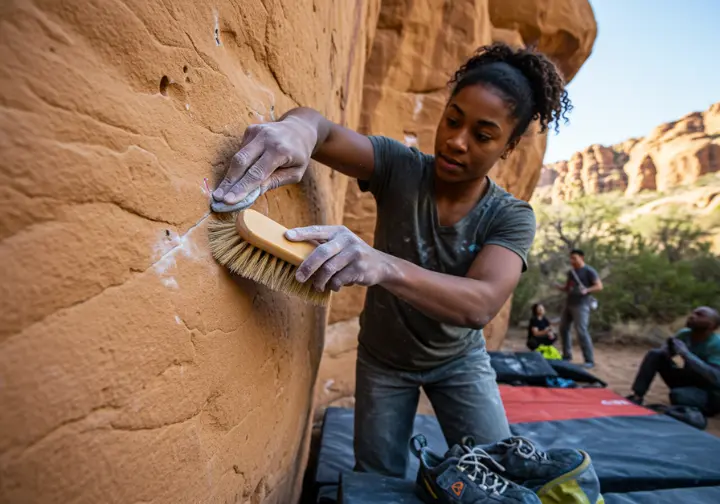
Moving from problems to solutions, it is constructive to outline the practical, actionable steps climbers can take to minimize their footprint. These include the tailored application of Leave No Trace principles and specific best practices related to gear, movement, and waste disposal for broad habitat protection.
Mastering Leave No Trace (LNT) for Climbers
The seven principles of Leave No Trace (LNT) provide a foundational framework for environmental protection, but they require specific interpretation for the vertical world of climbing. This specialized approach to Leave No Trace on the Crag involves planning ahead by researching local regulations and wildlife closures. Organizations like the Access Fund have developed climbing-specific LNT resources to guide this application.
A core tenet is to travel and camp on durable surfaces. At a crag, this means staying on established trails, avoiding cutting switchbacks, and choosing durable staging areas like rock or gravel at the base of climbs to prevent soil compaction and vegetation damage. This also extends to protecting sensitive biological soil crusts, which are extremely fragile.
Properly disposing of all waste is non-negotiable and includes packing out everything from microtrash like tape scraps and fruit peels to human waste. In many areas, using WAG bags or other portable toilet systems is the required and most responsible method. This preserves the aesthetic and ecological health of the climbing area and protects wildlife.
Responsible Gear Choices and Chalk Use
The placement of fixed gear like bolts is a permanent alteration to the rock layer and is often restricted, especially in a designated protected natural area where power drills may be prohibited. The climbing community generally encourages using removable protection where feasible and minimizing the visual impact of any fixed anchors by using camouflaged hardware and earth-toned webbing.
Beyond its potential to alter rock pH, the visual impact of chalk can be significant. Responsible use involves using chalk sparingly, cleaning tick marks and excess chalk off holds after climbing, and using a chalk bag with a secure closure to prevent spills. These simple actions collectively reduce the visual and ecological footprint of a climbing community on the land.
Climbers can consider alternatives to traditional mined chalk to further reduce their impact, which has a hidden ecological footprint of climbing chalk. Options include liquid chalk and colored chalk designed to match the rock. When using liquid chalk, it’s critical to choose products without pine rosin (colophony), which can permanently damage holds.
Ethical Route Development and Cleaning
Given that new route development has the most significant ecological impact, ethical development practices are paramount for cliff conservation. This involves prioritizing lines on plant-free rock faces where possible, minimizing vegetation removal to only what is necessary for safety, and avoiding damage to ancient trees or significant plant specimens. Chipping holds is widely considered unethical.
Before any new development, climbers have a responsibility to consult local ethics, Local Climbing Organizations (LCOs), and land manager guidelines. These groups can provide crucial information on sensitive areas, existing regulations, and community consensus. This collaborative approach helps prevent conflicts and ecological damage to these natural treasures.
The act of “cleaning” a route involves a complex balance between safety and ecological impact. Understanding that some slow-growing species like lichens and mosses may never recover from aggressive brushing is crucial. A conservative approach that prioritizes the health of the ecosystem is a cornerstone of modern, responsible route development.
Beyond the Individual: The Power of Community and Collaboration
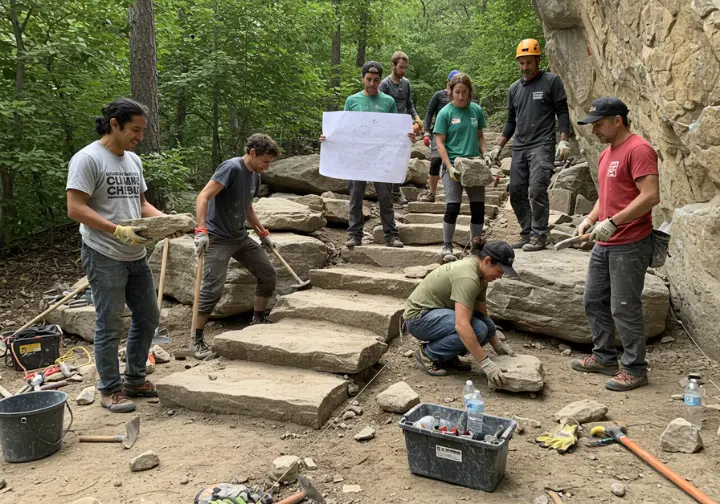
Collective action and organization amplify conservation efforts. It is powerful to explore the vital role of climber advocacy groups, partnerships with other stakeholders, and the power of citizen science and hands-on stewardship.
The Role of Climber Advocacy Organizations
National conservation organizations provide a unified voice for climber-led conservation. The Access Fund in the US works to keep climbing areas open and conserve the climbing environment by engaging in policy advocacy, acquiring threatened lands, and providing extensive climber education. On a global scale, the UIAA (International Climbing and Mountaineering Federation) promotes environmental responsibility through documents like the UIAA Sustainability Charter.
Local Climbing Organizations (LCOs), like the Utah Wilderness Alliance, are the backbone of on-the-ground stewardship, acting as the primary liaison between climbers and land managers. They organize trail days and manage local access issues. A great example is the Carolina Climbers’ Coalition’s work with wildlife agencies to monitor peregrine nests, enabling more targeted and effective conservation.
Partnering with Land Managers, Scientists, and Indigenous Communities
Effective cliff protection requires collaborative conservation efforts between climbers and land management agencies like the National Park Service (NPS). This partnership often results in the creation of Climbing Management Plans (CMPs) that formally balance recreational use with resource protection, ensuring sustainable access.
Engaging with scientists and conservationists is vital for developing a habitat conservation plan. Scientists provide the ecological expertise to monitor climbing’s impacts and validate the effectiveness of management actions, such as the adaptive raptor closures in Yosemite. This data-driven approach moves conservation beyond guesswork.
Recognizing and respecting the cultural and sacred significance of cliffs to Indigenous communities is a paramount ethical responsibility. Meaningful collaboration, such as the voluntary climbing abstention during culturally significant periods at Devils Tower, demonstrates a path forward that honors traditional ecological knowledge and deep cultural connections to the land.
Contributing through Citizen Science and Stewardship
Climbers are uniquely positioned to contribute to research through citizen science programs, as they can access remote cliff areas that are difficult for biologists to study. Programs like Climbers for Bat Conservation utilize climbers to gather valuable data on the location of sensitive bat species, helping to fill critical knowledge gaps.
The data collected by many rock-climbers—such as species location and date—provides crucial information for conservation efforts. This data can help biologists monitor populations, understand habitat use, and inform management decisions like the targeted placement of seasonal raptor closures, making them more effective.
Direct, hands-on involvement in stewardship programs is a powerful way to give back and strengthen the community’s conservation ethic. Opportunities include participating in trail building, erosion control, and crag clean-ups organized by groups like the Access Fund’s Conservation Teams, who host volunteer events across the country.
Conclusion: Our Shared Responsibility as Guardians of the Rock
The relationship between climbing and conservation is symbiotic; by protecting fragile cliff ecosystems, climbers also protect the future of the sport. We must go beyond simply following LNT principles. We should actively participate in conservation efforts by volunteering, supporting advocacy organizations, and contributing to citizen science. By embracing the identity of a “Guardian of the Rock,” we can ensure these vertical wildernesses thrive for generations to come.
Frequently Asked Questions about The Climber’s Role in Protecting Fragile Cliff Ecosystems
Is it ever okay to clean moss or lichen off a climbing route? +
What is the single biggest ecological impact from climbing? +
How do I find out about seasonal wildlife closures for nesting birds? +
Does climbing chalk actually harm the rock or plants? +
We are a participant in the Amazon Services LLC Associates Program, an affiliate advertising program designed to provide a means for sites to earn advertising fees by advertising and linking to Amazon.com. As an Amazon Associate I earn from qualifying purchases. We also participate in other affiliate programs. The information provided on this website is provided for entertainment purposes only. We make no representations or warranties of any kind, expressed or implied, about the completeness, accuracy, adequacy, legality, usefulness, reliability, suitability, or availability of the information, or about anything else. Any reliance you place on the information is therefore strictly at your own risk. Additional terms are found in the terms of service.



